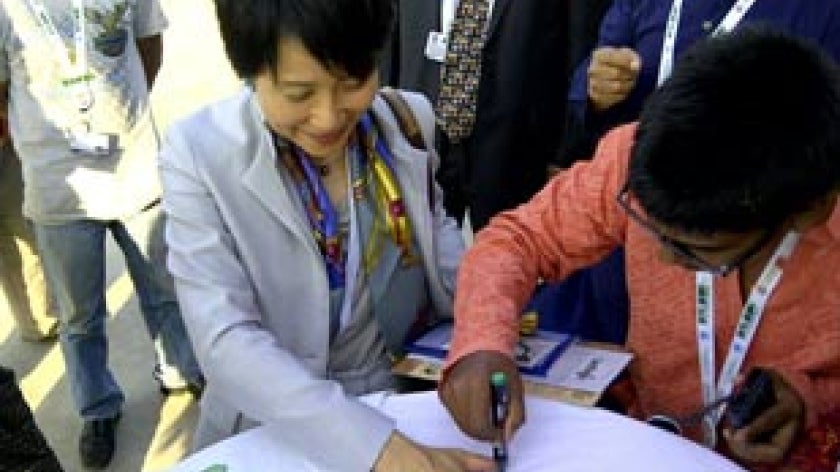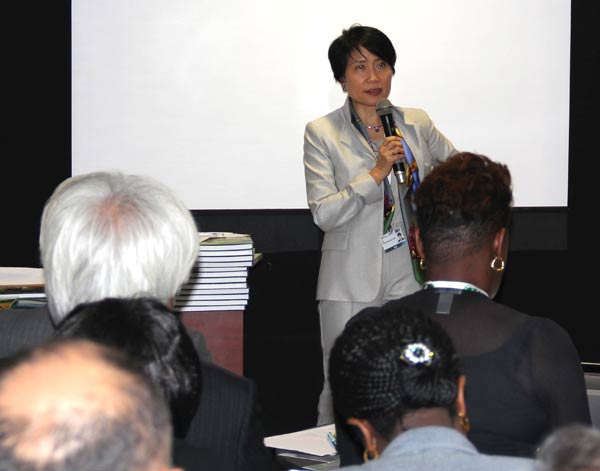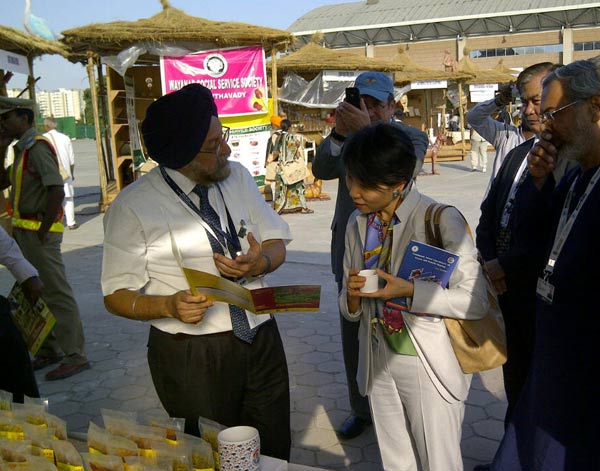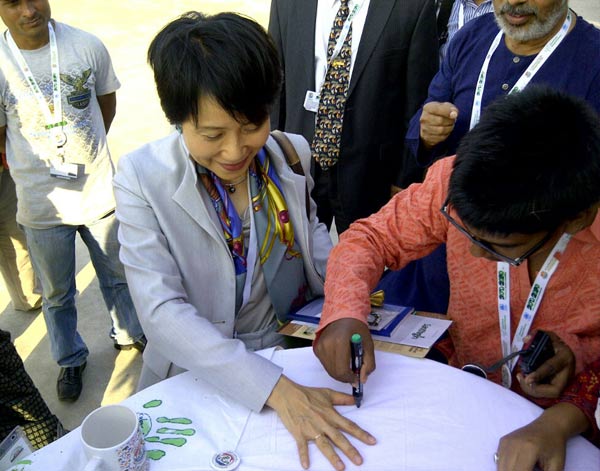
HYDERABAD, India, Oct. 15, 2012 – Making her first appearance at a global environmental conference, the CEO of the Global Environment Facility (GEF) today greeted delegates to the Convention on Biodiversity, holding its 11th formal Conference of Parties this week in southern India.
Dr. Naoko Ishii, who became the fourth CEO of the GEF on August 1st, after her unanimous selection by the GEF Council, touched upon major themes and challenges confronting the Convention, which seeks to protect and enhance a vast panoply of living things and living spaces, from the Amazon rainforest to the Great Barrier Reef. She also outlined the Vision Statement she issued a month into her tenure.
The Vision Statement lays out a plan to engage the GEF and its partners in innovative approaches to environmental problems, scaled-up efforts to protect the global environment, and close working partnerships involving international institutions, governments, indigenous peoples, civil society and the private sector – all with the GEF playing the role of financial catalyst, not only financing environmental projects but engaging other institutions to do so as well.

Dr. Ishii began by talking about the influence her experience in the field, including several years as World Bank Country Officer for Sri Lanka, has had upon her outlook now that she is at the head of a major international environmental institution. She also discussed the formidable environmental challenges confronting the planet, and the need for a scaled-up response.
"I just want to say that the challenge is enormous," Dr. Ishii said. "Incremental improvement is not good enough. We need to find a way to achieve transformational change."
Scaling up the global environmental effort will require close cooperation across institutions, Dr. Ishii said, down to the country and even the community level. The GEF and its partners should work for the countries, not the other way around, she pointed out.
With much of the discussion at the CBD COP focused on the need to generate greater financial resources to address threats to biodiversity, Dr. Ishii cautioned that money alone won't solve the problem.
"It's not only the money – we need to demonstrate what the money can do," Dr. Ishii said. After 21 years of supporting environmental projects, "We at the GEF have a good understanding of what works and what doesn't." The key is to apply those lessons skillfully, and at scale, she said.
Dr. Ishii fielded questions from CBD delegates, ministers and other participants on a range of topics, from environmental finance, to the architecture of the international environmental system, to the special threats confronting Asia's environment – particularly its coasts – to an emerging set of programs addressing threats to the deep oceans.
A key to success in the field of biodiversity lies in placing appropriate values on environmental assets, Dr. Ishii said.
"The entire problem stems from our failure to deal with global public goods," Dr. Ishii said. "That's why we need transformational change in the system which manages it." The private sector, she said, must be involved. "Without having the private sector as a partner, we cannot achieve transformational change."

She outlined the goals the global environmental community should achieve:
- All citizens recognize the fundamental links between environment and development, and all governments embed natural resource constraints into their decision-making;
- The value of natural capital is fully incorporated in the way decisions are made and progress is measured;
- All key actors – from local communities to national governments, the private sector, civil society organizations and indigenous peoples – recognize the part they must play in finding and implementing solutions;
- International environmental treaties are strong, fair and implemented on schedule; and
- Resources are adequately mobilized, and deployed towards programs that reflect the lessons learned from success and failure.
Dr. Ishii also outlined her vision for the GEF specifically, for the way ahead:
"I see four elements contained in this vision: First, the GEF is and must remain an innovator, second, the GEF is and must remain a champion of the Global Commons: third, the GEF is and must remain the partner of choice for environmental benefits, and last but not least, the GEF is and must remain a catalyst in the evolving architecture of environmental finance", she said.
Regarding the GEF vis-à-vis the CBD and the COP 11, she added: "The GEF is the largest and most wide-reaching financial mechanism for biodiversity globally. This does not mean that we have all, or even most, of the resources needed to fulfill the goals of the Convention on Biological Diversity and the associated Aichi Targets. To succeed, the GEF must retain its role as a catalyst in bringing other sources of financing, including the private sector. A key task here in Hyderabad is the financial needs assessment for the sixth replenishment of the biodiversity focal area in the GEF trust fund. At a time of fiscal austerity, GEF's catalytic potential is becoming an even more crucial factor, one that I intend to prioritize during my tenure."
Participants at the "Meet the GEF CEO" event used the opportunity not only to meet the new GEF CEO for the first time, but much more to discuss the urgent pertinent questions that are at the heart of the this conference: Mobilizing resources for biodiversity protection and giving guidance to the GEF for the following 2 years, until COP 12 in 2014.

GEF CEO Naoko Ishii has her hand traced at an exhibit at the CBD COP11 that highlight's the positive notion of the human handprint -- benefiting the environment -- as opposed to the human footprint harming the environment.
GEF photo: Christian Hofer